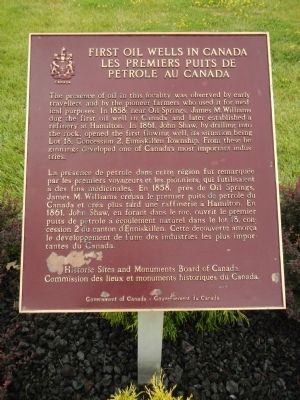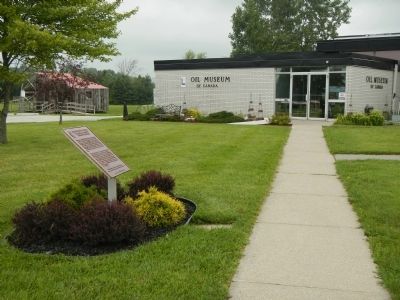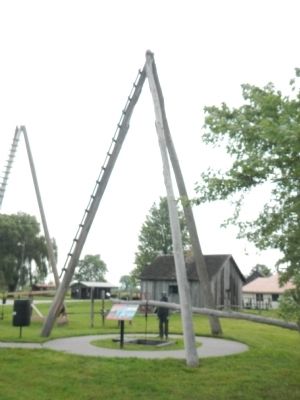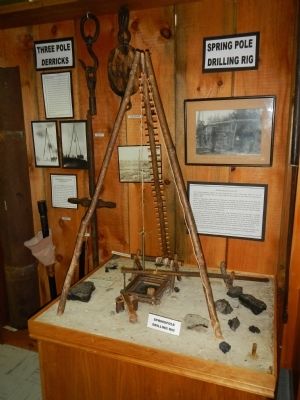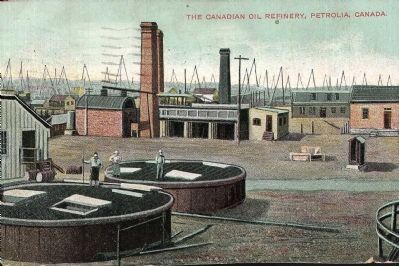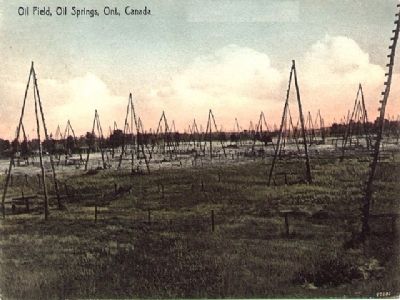Oil Springs in Lambton County, Ontario — Central Canada (North America)
First Oil Wells in Canada
Les Premiers Puits de Pétrole au Canada
The presence of oil in this locality was observed by early travelers and by the pioneer farmers who used it for medical purposes. In 1858, near Oil Springs, James M. Williams dug the first oil well in Canada and later established a refinery at Hamilton. In 1861, John Shaw, by drilling into rock, opened the first flowing well, its situation being Lot 18, Concession 2, Enniskillen Township. From these beginnings developed one of Canada’s most important industries.
French
La présence de pétrole dans cette région fut remarquée par les premiers voyageurs et les pionniers, qui l’utilisaient à des fins médicinales. En 1858, près de Oil Springs, James M. Williams creusa la premier puits de pétrole du Canada et créa plus tard un raffinerie à Hamilton. En 1861, John Shaw, en forant dans le roc, ouvrit le premier puits de pétrole à écoulement naturel dans le lot 18, concession 2 de canton d’Enniskillen. Cette découverte amorça le développement de l’une des industries le plus importantes du Canada.
Erected by Historic Sites and Monument Board of Canada/Commission de lieux et monuments historique du Canada.
Topics and series. This historical marker is listed in this topic list: Industry & Commerce. In addition, it is included in the Canada, Historic Sites and Monuments Board series list. A significant historical year for this entry is 1858.
Location. 42° 46.382′ N, 82° 7.25′ W. Marker is in Oil Springs, Ontario, in Lambton County. Marker can be reached from Kelly Road close to Gum Bed Line, on the left when traveling south. Touch for map. Marker is at or near this postal address: 2423 Kelly Road, Oil Springs ON N0N, Canada. Touch for directions.
Other nearby markers. At least 8 other markers are within 23 kilometers of this marker, measured as the crow flies. Victoria Hall (approx. 12.2 kilometers away); The Founding of Petrolia (approx. 12.2 kilometers away); Robert M. Nicol Library (approx. 12.3 kilometers away); The Founding of Dresden (approx. 20.9 kilometers away); Henson House (approx. 21.8 kilometers away); Josiah Henson (approx. 21.8 kilometers away); Spirituality and Community (approx. 21.8 kilometers away); Sawmill (approx. 21.8 kilometers away).
More about this marker. This marker is located on the grounds of the Oil Museum of Canada.
Also see . . . Oil Springs, Ontario. Before the village was formed, the indigenous people already knew about the gum beds and used the sticky oil to waterproof their canoes. The place, originally called Black Creek, became the
site of North America's first commercial oil well when asphalt producer James Miller Williams set out to dig a water well in 1858 and found free oil instead. (Submitted on October 31, 2014, by Barry Swackhamer of Brentwood, California.)
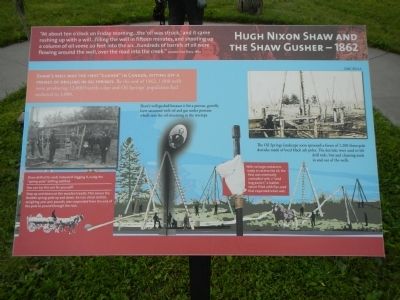
Photographed By Barry Swackhamer, August 12, 2014
4. Hugh Nixon Shaw and the Shaw Gusher - 1862
“At about ten o’clock on Friday morning… the ‘oil was struck,’ and it came rushing up with a will … filling the well in fifteen minutes, and shooting up a column of oil some 20 feet into the air… hundreds of barrels of oil were flowing around the well, over the road and into the creek.” - London Free Press, 1862
Shaw’s well was the first “gusher” in Canada, setting off a frenzy of drilling in Oil Springs. By the end of 1862, 1,000 wells were producing 12,000 barrels a day and Oil Springs’ population had rocketed to 3,000.
Captions: (left to right) Shaw drilled his well, instead of digging it, using the “spring-pole: drilling method. — You can try this out for yourself — Step up and down on the wooden treadle. This moves the flexible spring-pole up and down. An iron chisel drill bit, weighing 300-400 pounds, was suspended from the end of the pole to pound through the rock.; Shaw’s well gushed because it hit a porous, gravelly layer saturated with oil and gas under pressure which sent the oil streaming to the treetops.; With no large containers ready to receive the oil, the flow was eventually controlled with a “seed bag packer,” a leather sleeve filled with flax seed that expanded when wet.; The Oil Springs landscape soon sprouted a forest of 1,200 three-pole derricks made of local black ash poles. The derricks were used to lift drill rods, bits and cleaning tools in and out of the wells.
Shaw’s well was the first “gusher” in Canada, setting off a frenzy of drilling in Oil Springs. By the end of 1862, 1,000 wells were producing 12,000 barrels a day and Oil Springs’ population had rocketed to 3,000.
Captions: (left to right) Shaw drilled his well, instead of digging it, using the “spring-pole: drilling method. — You can try this out for yourself — Step up and down on the wooden treadle. This moves the flexible spring-pole up and down. An iron chisel drill bit, weighing 300-400 pounds, was suspended from the end of the pole to pound through the rock.; Shaw’s well gushed because it hit a porous, gravelly layer saturated with oil and gas under pressure which sent the oil streaming to the treetops.; With no large containers ready to receive the oil, the flow was eventually controlled with a “seed bag packer,” a leather sleeve filled with flax seed that expanded when wet.; The Oil Springs landscape soon sprouted a forest of 1,200 three-pole derricks made of local black ash poles. The derricks were used to lift drill rods, bits and cleaning tools in and out of the wells.
Credits. This page was last revised on January 24, 2022. It was originally submitted on October 31, 2014, by Barry Swackhamer of Brentwood, California. This page has been viewed 609 times since then and 17 times this year. Photos: 1, 2, 3, 4, 5, 6, 7. submitted on October 31, 2014, by Barry Swackhamer of Brentwood, California. • Andrew Ruppenstein was the editor who published this page.
